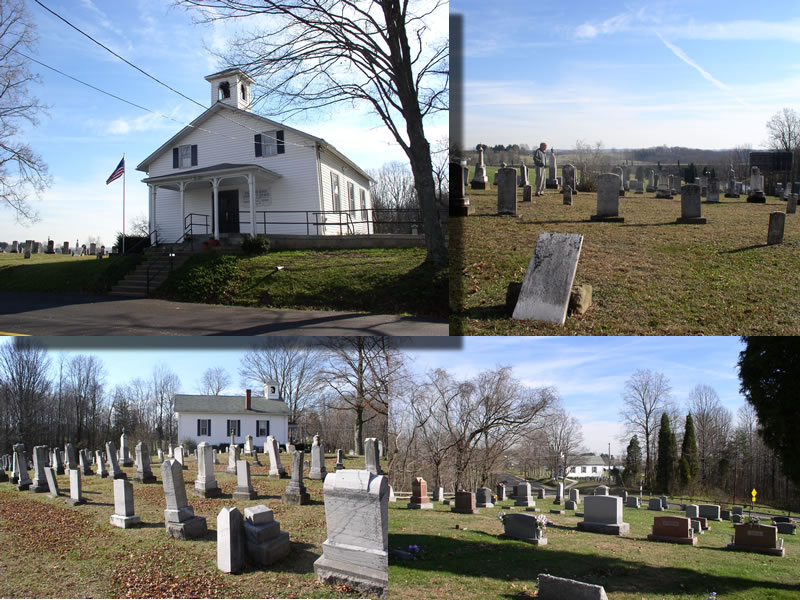Highland Ridge Community Church and Cemeteries
Of all the churches visited by Daniel Hirsch, the Highland Ridge Community Church (currently affiliated with the United Church of Christ) is the only one which still has regular Sunday Services. It has been called by various names during its 172 year history, but stood in the German Evangelical Protestant tradition until well into the 20th Century. Location: CR 8 in Muskingum Township.

Founding of the church
The German settlement on Highland Ridge (see map) began in the decade of the 1830's. Among these settlers was a group of seven families from Dittweiler (then in the Bavarian Pfalz) who settled on the ridge in 1834, and these included Johann Gerhard, whose 1912 obituary records this fact. These settlers longed to establish a German church which would carry on their religious traditions. At first they worshipped in each other's homes. Later they would sometimes attend English preaching services at the Cedar Narrow on Duck Creek in Fearing Township. Still, they longed to hear the Gospel preached in their native tongue.
From the beginning of their arrival on Highland Ridge, these settlers held as one of their objectives the building of a church that would offer services in German. There were materials available for such a situation and a will to do the necessary work. Within just a couple of years, they had built a log church and identified a person who would serve as pastor. The church treasury was begun October 11, 1835 by Herr Gerber. The hewn log building was completed in 1836 on land owned by Stephen and Sally Otis. The lot for the building and for its adjoining cemetery was deeded to the church on March 19, 1939.
Around 1835 or 1836, members identified a Theodore Schreiner who would be their clergyman from 1835 to 1854. Rev. Schreiner had immigrated to the next township, Fearing, in 1833 at the age of 22. His father was a minister who undertook Theodore's education, but died before the process was complete. We read in Matt's translation of an 1880's church document, "Being a man of education, a minister's son and withal a Godly man, what [would be] more proper than that he be called to become the shepherd of this little flock among the hills. Having decided to pick up the ministerial duties which his father had been compelled to lay down at his death, he went heartily into the work and soon effected the organization of a society of not less than twenty members." A record exists that the church treasurer paid Theodore Schreiner $6.25 on Christmas Day of 1837 for making benches for the church.
Schreiner had let a group of about 75 former inhabitants of the Bavarian Palatinate to America, where they purchased land west of Duck Creek and settled there. This was part of a larger exodus from Germany as a result of the supression of those who participated in the Hambach Festival (May, 1832), demanding a constitution, a free press and German unification. Their church in Germany had been called the Unified Protestant Evangelical Christian Church of the Palatinate.
Later Events
In 1849, over ten years after Rev. Schreiner assumed the pastorate, Jacob Baker began to build a frame church to replace the hewn log structure. The building was dedicated on December 16 of that year. After Schreiner stepped down in 1854, a succession of clergy presided at the church, mostly in one year cycles, except for a Rev. Jeergens who served from 1858-1868, and later, Sebastian Beach, 1873-1900.
Several milestones have been recorded for this church during the last half of the 19th Century. A constitution exists from 1857. The church wanted a full time minister and separated from the Lowell Church around 1868. In 1869 John Gerhart sold more land to the church so that the cemetery could be enlarged. In the early 1880's nearly a hundred members were on the church roll, and a church organ was purchased.
Otto Breuhaus led the 4th generation of this band of Pfalzer immigrants 45 years into the 20th Century. In 1913 English was introduced into the regular service, but for many years German and English were alternated.
References
- Becker, Heinrich, "Von den bergessenen Töchtern und Söhnen Dittweilers," in Wir "Diewiller Waffele:" Geschichten aus un um Dittweiler zum 675. Jubiläum der Erwähnung 1316 und 12. Kreisheimattag
- Becker, Heinrich, "About
the Forgotten Daughters and Sons of Dittweiler,"
translated by Jim Andris - German-American Communities, Churches, Cemeteries, Records and other Sources Washington County and Adjoining Townships in Noble and Monroe Counties, Ohio, information compled by Millie Covey Fry of Marietta, Oh, December 30, 2001; December 4-7, 2006, January 30, 2007. Information provided by Donna Betts, Kurt Ludwig, Catherine Sams, Ernest Thode, and Dean Zimmer.
- Matt, Barbara Gerhart, translations of the Berg Church Records of Daniel Hirsch.
- Nikolaus, Walter, Daniel Hirsch: Lehrer—Revolutionär—Pfarrer: 1848; Freiheit und Einheit Deutschland un Europa, unpublished manuscript.
- Portions of an email from Ernest Thode to others on the Historical Background of St. Paul's and St. Lukes.
- Zenglein, Dieter, with collaboration from Walter Nokolaus and Heinrich Becker, To the Banks of the Ohio: An Essay on Emigration of People from the Kohlbach ("Coal Creek") Valley to America Especially Washington County, Ohio, in the 19th Century. tr. by Ernest Thode, 1988. (This work contains the following subsections: 1) Introduction, 2) Johann Theobald Schramm and Jacob Berg of Altenkirchen, Two Pioneers of the Kohlbach Valley in the New World, 3) The Great Emigration Wave from the Kohlbach Valley to Ohio in the 19th Century, 4) Daniel Hirsch, Teacher, Pastor, and Democrat: Fate of a Forgotten '48er, 5) The West Palatine Emigrant Community in Washington County, Ohio, and 6) Church Book of the First Evangelical Protestant Congregation in Fearing Township, Washington County, Ohio, begun in 1856 by Daniel Hirsch, formerly teacher in (D-6791) Altenkirchen, and continued until 1914.